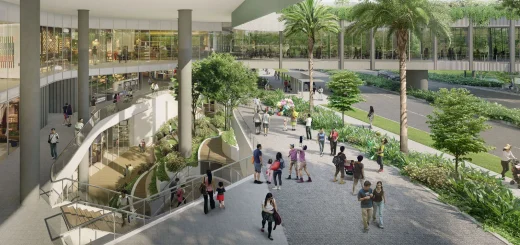About Sungei Kadut Eco District Transformation
Nestled in the northwestern part of Singapore lies Sungei Kadut, a district known for its industrial and manufacturing activities. However, in recent years, this area has undergone a major transformation to become the Sungei Kadut Eco District, a sustainable and green hub for the future.
The idea of transforming Sungei Kadut into an eco-district was first introduced in 2014 by the Urban Redevelopment Authority (URA). The aim was to create a model for sustainable development that could be replicated in other parts of Singapore. This vision was further solidified in 2016 when Sungei Kadut was designated as an eco-district under the Sustainable Singapore Blueprint.
So, what exactly is an eco-district? An eco-district is a community that is designed and developed with sustainability in mind. It focuses on creating a balance between economic growth, social well-being, and environmental protection. In the case of Sungei Kadut, this means transforming the district into a green and livable space that promotes sustainable living and working.
One of the key features of the Sungei Kadut Eco District is its emphasis on green spaces. The district is home to several parks and nature reserves, including the Kranji Marshes and the Sungei Buloh Wetland Reserve. These green spaces not only provide a recreational area for residents but also serve as a natural habitat for various flora and fauna.
In addition to green spaces, the district also boasts of sustainable buildings. The URA has set a target for all new buildings in Sungei Kadut to achieve at least a Green Mark GoldPlus rating, which is the second-highest level of certification for green buildings in Singapore. This means that these buildings are designed and constructed to be energy-efficient, water-efficient, and environmentally friendly.
But the transformation of Sungei Kadut into an eco-district is not just about buildings and green spaces. It also involves creating a sustainable and circular economy. This means reducing waste and maximizing the use of resources. One of the initiatives in place is the Sungei Kadut Eco-District Industrial Symbiosis (SKEDIS) program, which encourages companies in the district to exchange resources and by-products to reduce waste and increase efficiency.
Another aspect of the eco-district is promoting sustainable transportation. The district is well-connected with public transportation, including the upcoming MRT line, making it easier for residents and workers to commute without relying on cars. Additionally, there are plans to introduce more cycling paths and pedestrian-friendly streets to encourage active and sustainable modes of transportation.
The Sungei Kadut Eco District also places a strong emphasis on community involvement and education. The URA has partnered with various organizations to conduct educational programs and workshops for residents and businesses in the district. These programs aim to raise awareness about sustainability and encourage individuals to adopt eco-friendly practices in their daily lives.
The transformation of Sungei Kadut into an eco-district is a long-term project, with plans in place until 2030. However, the district has already seen significant progress in its sustainability efforts. In 2019, Sungei Kadut was awarded the BCA Green Mark Platinum District Award, the highest accolade for a district-level certification in Singapore.
There has been many food factories that sprung up at Mandai Estate such as Smart Food @ Mandai to ride this Sungei Kadut Eco District transformation.
Sungei Kadut Eco District is a prime example of Singapore’s commitment to sustainable development. With its focus on green spaces, sustainable buildings, circular economy, and community involvement, the district is well on its way to becoming a model for sustainable living and working. As we continue to face environmental challenges, the Sungei Kadut Eco District serves as a beacon of hope for a greener and more sustainable future.
Exploring the Green Initiatives of Sungei Kadut Eco District
Sungei Kadut Eco District, located in the northwestern part of Singapore, is undergoing a major transformation to become a sustainable and eco-friendly district. This initiative is part of Singapore’s larger goal to become a “City in a Garden,” where nature and urban development coexist harmoniously.
The district, which was once known for its industrial activities and factories, is now being redeveloped into a green and livable space. The transformation of Sungei Kadut Eco District is a collaborative effort between the government, businesses, and the community.
One of the key initiatives of this transformation is the integration of green spaces and biodiversity into the district. The district will have a network of parks, gardens, and green corridors that will not only provide recreational spaces for the community but also serve as habitats for various flora and fauna.
To achieve this, the government has set aside 100 hectares of land for green spaces, which is equivalent to the size of 140 football fields. These green spaces will be connected through a network of cycling and pedestrian paths, promoting a car-lite and active lifestyle.
In addition to green spaces, the district will also have sustainable buildings that are designed to be energy-efficient and environmentally friendly. These buildings will incorporate features such as solar panels, rainwater harvesting systems, and green roofs to reduce energy consumption and carbon footprint.
But the transformation of Sungei Kadut Eco District is not just about creating green spaces and sustainable buildings. It also aims to promote a circular economy, where waste is minimized, and resources are reused and recycled.
One of the ways this is being achieved is through the development of an eco-industrial park. This park will house businesses that adopt sustainable practices, such as using renewable energy and implementing waste reduction measures. The businesses in the eco-industrial park will also collaborate to exchange resources and by-products, creating a closed-loop system.
The district will also have a food waste management system, where food waste from businesses and households will be collected and converted into compost or energy. This not only reduces the amount of waste sent to landfills but also creates a valuable resource for agriculture and energy production.
Another exciting initiative of Sungei Kadut Eco District is the development of a floating solar photovoltaic (PV) system. This system will be installed on the reservoirs in the district, generating clean energy while also reducing water evaporation. This innovative solution not only maximizes the use of space but also helps to mitigate the effects of climate change.
The transformation of Sungei Kadut Eco District also involves the community, with various educational and outreach programs to raise awareness and encourage sustainable practices. These programs include workshops, guided tours, and community gardening projects.
The district also has plans to incorporate smart technology, such as sensors and data analytics, to monitor and optimize energy and resource usage. This will not only improve the efficiency of the district but also provide valuable data for future sustainable developments.
In conclusion, the transformation of Sungei Kadut Eco District is a significant step towards creating a more sustainable and livable city. With its focus on green spaces, sustainable buildings, circular economy, and community involvement, the district is set to become a model for other cities around the world. It is an exciting time for Sungei Kadut, and we can’t wait to see the district flourish as a green and vibrant hub.
The Role of Technology in Sungei Kadut Eco District’s Transformation
Sungei Kadut, a district in the northwestern part of Singapore, is undergoing a major transformation into an eco-friendly and sustainable district. This transformation is not only focused on preserving the environment, but also on improving the quality of life for its residents. One of the key factors driving this transformation is the use of technology.
Technology has played a crucial role in the development of Sungei Kadut Eco District. From the planning stage to the implementation of various initiatives, technology has been integrated into every aspect of the transformation process.
One of the main ways technology is being utilized in Sungei Kadut is through the use of smart systems. These systems are designed to monitor and manage energy usage, waste management, and water consumption. For instance, the district has implemented a smart lighting system that uses motion sensors to turn off lights in unoccupied areas, reducing energy wastage. This not only helps to reduce the district’s carbon footprint but also saves on energy costs.
Another example of technology being used in Sungei Kadut is the implementation of a smart waste management system. This system uses sensors to monitor the fill levels of waste bins, allowing for more efficient waste collection and reducing the number of collection trips needed. This not only saves time and resources but also reduces the amount of carbon emissions from waste collection vehicles.
In addition to smart systems, Sungei Kadut is also utilizing renewable energy sources to power the district. Solar panels have been installed on the rooftops of buildings, providing clean and sustainable energy. This not only reduces the district’s reliance on non-renewable energy sources but also helps to reduce carbon emissions.
Technology is also being used to improve the quality of life for residents in Sungei Kadut. One example is the implementation of a smart traffic management system. This system uses real-time data to monitor traffic flow and adjust traffic signals accordingly, reducing congestion and improving the overall traffic flow in the district. This not only saves time for residents but also reduces air pollution from idling vehicles.
Another way technology is enhancing the quality of life in Sungei Kadut is through the use of smart homes. These homes are equipped with energy-efficient appliances and devices that can be controlled remotely through a smartphone app. This allows residents to monitor and manage their energy usage, reducing their carbon footprint and energy costs.
Apart from these initiatives, technology is also being used to promote sustainable living in Sungei Kadut. The district has implemented a smart water management system that uses sensors to monitor water usage and detect leaks. This not only helps to conserve water but also reduces the risk of water wastage and damage to infrastructure.
Furthermore, technology is being used to educate and engage residents in sustainable practices. The district has a mobile app that provides information on eco-friendly initiatives, tips for sustainable living, and updates on the district’s progress towards its sustainability goals. This helps to raise awareness and encourage residents to play an active role in the transformation of Sungei Kadut.
In conclusion, technology has played a crucial role in the transformation of Sungei Kadut into an eco-friendly and sustainable district. From smart systems to renewable energy sources, technology has been integrated into every aspect of the district’s development. With these initiatives in place, Sungei Kadut is well on its way to becoming a model eco-district, setting an example for other cities and communities to follow.










